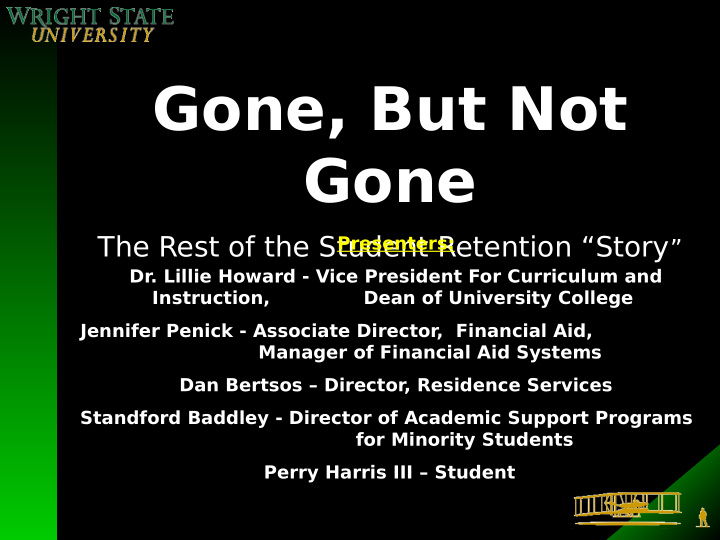



Gone, But Not Gone The Rest of the Student Retention “Story ” Presenters: Dr. Lillie Howard - Vice President For Curriculum and Instruction, Dean of University College Jennifer Penick - Associate Director , Financial Aid, Manager of Financial Aid Systems Dan Bertsos – Director , Residence Services Standford Baddley - Director of Academic Support Programs for Minority Students Perry Harris III – Student
Presentation Overview “Gone, But Not Gone” students have neither left the university nor remained offjcially enrolled, but they often escape our retention efgorts because they look and behave like offjcially enrolled students. This session will look at what we are learning and how we are responding to this phenomenon at Wright State University; show how FAFSA and housing data can serve as predictors and lead to appropriate early intervention; and feature one “gone, but not gone” student who has recently re-enrolled at the University.
About Wright State: • Main campus at Dayton, OH; Branch campus in Celina , OH • Founded in 1964 as part of Miami University and Ohio State University • Became independent, state-assisted university in 1967 • Celebrating 40th anniversary in 2007! • Named after Wilbur and Orville Wright • Located adjacent to Wright Patterson Air Force Base (WPA FB).
Student Body Profile • Open Access Institution • 17,000 Students • 13,000 Undergraduates • 4,000 Graduate Students • 57% Female Students • 43% Male Students • 14.5% Students of Color • 91% From the State of Ohio • 562 International Students from 67 Countries • 312 Students with Disabilities
Handouts :
Financial Aid at Wright State University • 11,131 of 17,000 receive aid (65.4%) • 2005-2006 awarded $122,702,972 in aid • Cost Of Attendance: $19,383 • Average undergraduate award: $9,787
Who are the Students Who get into Financial Difficulties? • First Year Students • Residential Students • Students with Disabilities • Dependent Student Status • PLUS denial • Standards of Academic Progress • Change in circumstances
Identifying Students who could be Gone, But Not Gone • Demographic/Biographical info • Financial Aid Data • Standards of Academic Progress • Characteristics of the Aid Award • FAFSA Data
WSU Student Housing Options: • Residence Halls – Double Loaded Corridors – Suites – Single/Double/Triple/Quad • On Campus Apartments – Shared/Individual Lease – Furnished/Unfurnished • Special Interest Housing – Living/Learning Communities – Fraternity/Sorority blocks • Ofg-Campus – Home/Commuter – Apartments • No Campus Housing obligation • 9 & 12 month agreements • University (20%) and privately owned, WSU or o/c landlords
Residents Gone, but not Gone • Early indicators: – Unregistered after fjrst registration opportunity deadline – Positive balance on Bursar’s account – Interruption in Financial Aid award cycle • Interventions – Individual contact via stafg – Consult Financial Aid & University College – Referral to appropriate offjce(s) • Other Concerns – Room Selection Lottery Timing & Ofg-Campus Competition – Actions, Priorities & Consequences of Private Landlords
Perry Harris III: Gone, But Not Gone Student • Originally from Sylvania, OH • Graduated in 2001 • Began attending Wright State Fall 2001 • Majoring in English Education • President Of Hamilton Hall Community Gov’t • Secretary of Black Men on the Move • Vice President of Black Men on the Move • President of Black Men on the Move • Director In HIS Presence Gospel Choir* • President of In HIS Presence Gospel Choir • President Black Student Union* • 2005 Wright State Univ. Homecoming King* All Positions held while “Gone But Not Gone”
Perry Harris III: Gone, But Not Gone Student • Was not offjcially registered for classes since Winter 2006 – Low GPA – Not enough credit hours to keep fjnancial aid • Continued to hold all positions, titles, offjce hours and run meetings • Served as a Goodwill Ambassador for the University
Factors Contributing to Departure • Ever-increasing education/living cost and diminishing fjnancial aid • Students unprepared for academic/fjnancial responsibilities. • Students seek membership in social groups and students organizations as a means of gaining validation and affjrmation on campus, but the academic component takes a distant second place • Vagueness in university policy and defjnition of “enrollment status” • Students overwhelmed, serving in as many as three organizations. • Students fail to set realistic goals with adequate time to meet them.
Targeted Intervention Strategies • Be proactive and identify potential Gone, But Not Gone students before they leave the university. • Focus on getting students engaged and connected academically to the campus, particularly during the freshmen year. • Monitor students involvement in student organizations by proposing and developing a co-curricular transcript. • Develop and implement a more intrusive follow up procedure when students are placed probation for failing to meet standards of academic progress.
Additional Intervention Strategies • Back to School Program • TEACHERS Program • REACH Program • Pass Program • Learning Communities • Residential Communities
Summary Remarks & Discussion
Recommend
More recommend